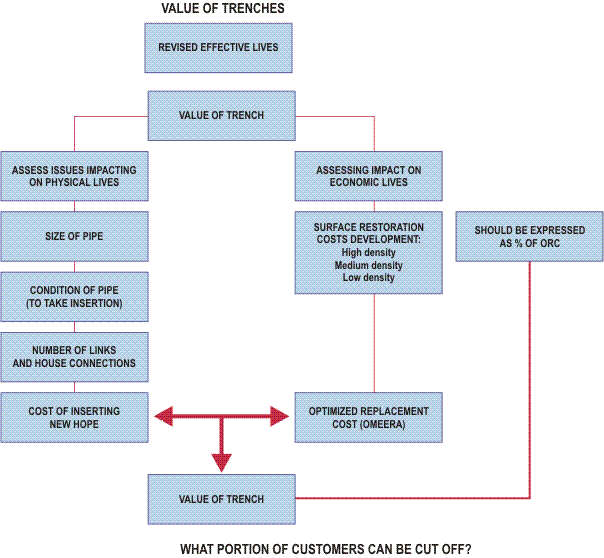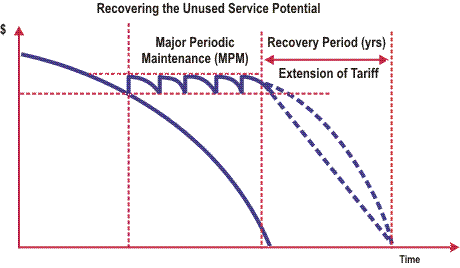Depreciation
The key principles related to determining the depreciated replacement cost for the optimized deprival valuation are:
- Applying straight line depreciation, the unexpired portion of the asset cost is calculated by applying the ratio of the remaining life over the standard economic life to the asset value. The remaining life is generally calculated by deducting the actual age of the asset from the standard economic life. Alternatively it may be calculated by assessing the time remaining before replacement, refurbishment, or abandonment of the asset.
- Where optimization notionally replaces an existing asset with an optimized equivalent (eg. of smaller rating or modern technology), then the optimized assets are to be depreciated to reflect the weighted average remaining life of existing assets.
- Where optimization notionally replaces a group of assets with a group of reconfigured assets, then the reconfigured assets are to be depreciated as a group to effect the same overall depreciation (ie to have the same remaining life, weighted) as the group of existing assets.
Minimum Remaining Life
- The DORC methodology recognizes a minimum remaining life for all assets still in use. Effectively the minimum remaining life retains a minimum value for an asset that would otherwise be depreciated to a nil value even though the asset is being utilized in the network.
- An engineering assessment is required of the asset’s operating environment to determine the level of minimum remaining life to be assigned. At the least this value should be one year.
- A more realistic indication of the depreciation rate of an asset which has been in service for longer than its SEL is to modify the SEL by including the minimum remaining life (MRL) or part thereof if the theoretical remaining economic life (REL) of the asset is less than the minimum remaining life. However, this order of accuracy is not warranted if the SEL is reasonably accurate and hence the practical approach is to adopt the same SEL in calculating the depreciation rate.
Trench Value
- Many networks have older cast iron pipes still in use. The possibility of using pipe insertion technology to lay PE pipes in existing cast iron pipes gives rise to a minimum value of the trench or “hole in the ground”. This represents the savings or an opportunity cost relating to the value of not having to dig a trench to lay the PE pipe and only incurring the insertion costs.
- The valuation recognizes this value by only depreciating the existing cast iron pipe to the higher of the minimum remaining life or the trench value for the cast iron pipe.
- Consideration has to be given to the feasibility of insertion, including the utility’s operating policy before making this adjustment. Pipe insertion is generally applicable where the existing pipe is oversized. In addition, use of pipe insertion should ensure compliance with code requirements (e.g. minimum cover) or existing contractual obligations (e.g dedicated assets).
- Different utilities have different experience with respect to the success rates and also with the amount of cost savings achieved through this method because of the nature of their network configurations and the type of expertise available. It is generally impossible to identify each asset likely to be replaced by this technique so the valuation model usually recognizes assets affected by this on a grouped basis.

Residual Value
- In some situations, the issue of a residual value may arise, ie. at the end of its SEL, a class of assets may have a residual or salvage value. This issue may arise particularly where the asset is not totally replaced as new, but is refurbished with a substantial amount of components replaced. In this situation, the residual value (RV) is equal to the cost of total replacement, less the cost of refurbishment, assuming the refurbishment brings the asset to “as new” condition.
- Generally the residual value of distribution assets is low (once the cost of recovering them is netted off) and can be safely ignored.
Recovering the Unused Service Potential
- An argument for not depreciating infrastructure assets during their ‘steady state’ period (early in the life of new assets when there is relatively little deterioration) is that these assets are continuously being maintained and renewed through Major Periodic Maintenance (MPM) programs that are also being charged to the customers.
- MPM are different from the normal, routine maintenance activities, which are performed to retain the infrastructure assets as near as practical to its serviceable condition, but without enhancing its service potential. As illustrated in the following diagram, MPM are major renewal works that result in enhanced service potential of the assets or extension of the service life.
- Without major periodic maintenance, the asset condition will still deteriorate over time. MPM restores the service potential of the assets to a higher level whenever the condition is such that the desired level of service is not achieved.

- An alternative to charging the MPM as they occur is to estimate the renewal annuity due to these MPM and to include this renewal annuity as part of the rate. Including the renewal annuity has the advantage of evenly distributing the costs (annual equivalent costs) due to MPM and therefore provides more certainty to the customers in terms of price stability. However, renewal annuity calculation requires that the MPM during the regulatory period needs to be fully costed upfront and additional data relating to the condition of the assets, the appropriate treatment options etc need to be collated.
- If the infrastructure assets can be maintained in the steady state in perpetuity, there is no problem with the unused service potential approach. However, this may not be the case since there may be a limit to the economic life. There remains the issue of recovering the unused service potential of the assets since presumably these assets are there solely for the purpose of transporting the gas or the coal from the mine. At some point in time before the supply of the transported materials run out and the asset owners need to recover the undepreciated portion of the assets in the form of depreciation charges.
- It is expected that during this period the MPM will be slowly phased out and the depreciation charges need to be included as part of the rate. This can be achieved by extending the last regulatory period and the rate for the purpose of recovering the undepreciated portion of the assets.
Under straight line depreciation, the depreciated value of an asset is:-
DV = RC x REL / SEL
Where: DV = depreciated value
RC = replacement cost of the MEE
REL = remaining economic life of the existing asset
SEL = standard economic life of the existing asset.
It is logical to use the age and the standard economic life of the existing asset instead of those of the MEE because it is the existing configuration which dictates the performance and hence the rate of depreciation of the system.
The calculated depreciated value (DV) of an asset should in no case be less than the higher of the value attributed to the minimum remaining life or its residual value, if any; or less than the higher of the value attributed to the minimum life or its trench value, in the case of mains and services.